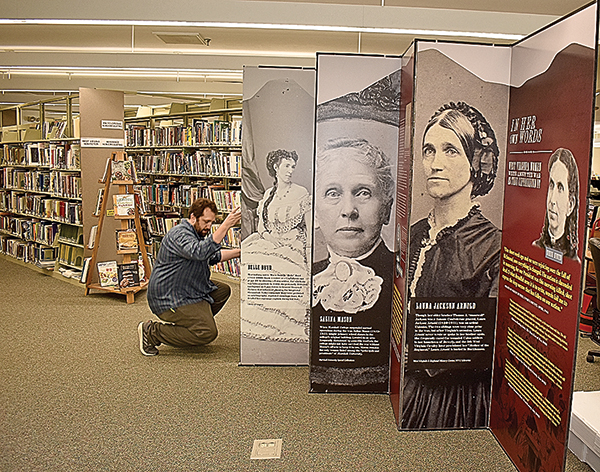
Suzanne Stewart
Staff Writer
All West Virginians know the importance of June 20, 1863 – the day the Mountain State was officially formed.
The days, weeks and years leading up to it were full of blood, sweat and tears – the Civil War was raging, and the state of Virginia was being torn apart by differences that could not be settled.
That battle is the subject of the latest West Virginia Humanities Council exhibit to travel to Pocahontas County. “Born of Rebellion” retells the story of the tumultuous time in American History that led to the formation of this great state.
Last Tuesday, Humanities Council program officer Kyle Warmack and Pocahontas County librarian Margaret Worth spent the day traveling from library-to-library in the county setting up the exhibit for its six-week run in the county.
Worth said she first learned of the exhibit from the Humanities Council newsletter and after seeing it on display at West Virginia Wesleyan University, she knew it would be great to have it come to the county.
Unlike other places the exhibit has been, it will be spread out here with panels at each of the five county libraries.
“That’s a West Virginia first,” Warmack said. “It’s been touring the state for a year, but it’s always been in one location.”
The only place in the county that could have possibly housed the entire exhibit is the Pocahontas County Opera House, but Worth said that would have taken six weeks of programming possibilities away from the venue, so she worked with Warmack on planning the separation of the exhibit for the libraries.
The exhibit was designed by West Virginia University graphic design students in collaboration with the Humanities Council. The panels are connected in a zig zag pattern that creates a welcoming atmosphere, as well as an interesting illusion when viewed in just the right way.
“Two of the sections have one lenticular piece,” Warmack explained. “There is a picture of a black school in Wheeling shortly after the Civil War. It was one of the first black schools in the state, so we have a photograph of the students and the teachers.”
The photograph is divided onto three panels and when they are viewed from the right angle, the picture lines up perfectly.
“All credit has to go to the WVU design kids on that one,” Warmack said. “There were a number of different designs that were proposed during the pitch phase. There was a specific group that pitched that lenticular design, and it was just too cool to resist.”
The exhibit is on display now at the five libraries and will be here for six weeks. A special map was printed by the Humanities Council to show which portions of the exhibit are at each library.
While the panels are in order from north to south, going from Durbin, Green Bank, Linwood, Marlinton and Hillsboro, it is not necessary to see them in that order to get the impact of the exhibit.
The maps and a newspaper featuring articles connected to the exhibit are available at the five libraries.
For more information on the exhibit, visit wvhumani ties.org/programs/traveling-exhibits/bor



